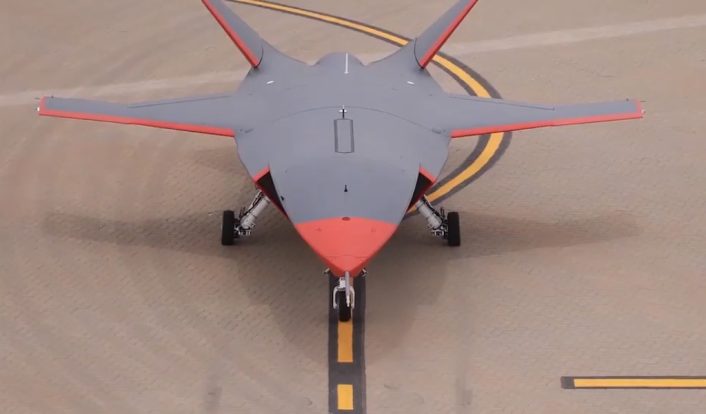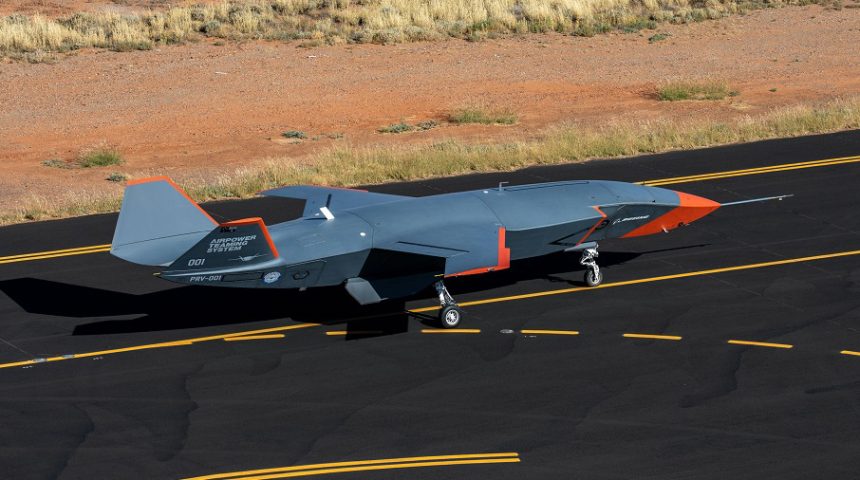The Boeing’s Loyal Wingman completed high-speed taxi test at RAAF Woomera Airfield.
Boeing Australia and the Royal Australian Air Force (RAAF) have completed the first high-speed taxi test of the Airpower Teaming System (ATS) unmanned aircraft, also known as Loyal Wingman. The unmanned aircraft is undergoing low-, medium-, and high-speed taxi testing at a remote test location in Australia, with Boeing’s technicians closely monitoring the aircraft’s performance and instrumentation from a ground control station.
“Our test program is progressing well, and we are happy with the ground test data we have collected to date,” said Paul Ryder, Boeing Flight Test manager. “We are working with the Air Warfare Centre to complete final test verifications to prepare for flight testing in the new year.” According to the press release, the joint Boeing/RAAF team will resume final taxi tests and preparations for flight in early 2021 when an unspecified range reopens.
Check out #LoyalWingman outfitted in flight test orange! It’s reached high-speed taxi testing with @AusAirForce ahead of first flight in 2021. #AirpowerTeaming pic.twitter.com/u97LbxFnsV
— Boeing Defense (@BoeingDefense) December 20, 2020
Back in August we reported about some spotters who sighted the ATS being towed in an airport in Queensland, which was assessed to be RAAF Base Amberley, home of Boeing Australia. It appears that the aircraft has now been moved to a new remote location, as mentioned by Boeing, after the completion of the low-speed taxi trials. From the video posted by the company, we were able to geolocate the new test location by using publicly available satellite imagery.
The airport showed in the video is, in fact, RAAF Woomera Airfield, part of the RAAF Woomera Test Range Complex (the unspecified range mentioned in the press release) used by the Air Warfare Centre. The range is located in South Australia, approximately 450 km (280 mi) north-west of Adelaide and about 1080 km (670 mi) south-west of RAAF Amberley, where the Loyal Wingman was first spotted. The range is a major military and civil aerospace facility, which has also been recently used as a landing site for the sample-return capsule from the Japanese space probe Hayabusa2 after visiting asteroid 162173 Ryugu. The same location was also used in 2013 for the first flight of the BAE Systems Taranis, a British stealthy Unmanned Combat Aerial Vehicle (UCAV) technology demonstrator program.
RAAF Head of Air Force Capability Air Vice-Marshal Cath Roberts visited the airfield to attend the test. “Seeing the Loyal Wingman during the trials has been extraordinary. There is something very special about testing an aircraft that takes technology to the next level. It is iconic in its own way,” she said. “Experiencing the enthusiasm of the Boeing and Air Force team reminded me of my early career testing aircraft. This is what innovation is all about – working together to achieve many firsts”.

After the roll-out ceremony in May 2020, the test and evaluation program of the Boeing ATS moved quickly, completing the first engine run in September and the first low-speed taxi in October. By the way, the engine used by the ATS has not been revealed yet, with only available info describing it as a fuel-efficient business jet turbofan derivative providing about 8,000 lbs of thrust. Now that the aircraft is getting closer to its first flight, it has also received a new high-visibility paintjob, with the tips and leading edges of wings and stabilizers, the outline of the air intake and a large portion of the nose cone painted with a bright orange.
As we wrote in occasion of the roll-out, this drone is the first clean-sheet design created by Boeing outside the United States and also the first RAAF’s clean-sheet design in more than 50 years. The project, which involved several Australian companies, used new development techniques, like the “digital twin” concept, and new automated production systems.
One of the key features of the ATS is an 8.5 ft (2.6 m) long modular nose cone with 9000 cubic inches internal volume to house different payloads, which can be entirely swapped quickly according to the mission’s needs.
Air Marshal Hupfeld, Chief of the Royal Australian Air Force, noted that the RAAF is working on the policies to understand the discipline that an airman should apply to a system like the Loyal Wingman, highlighting that this is one of the key points of the program: ”The heart of it is about the systems that are inside that platform. The artificial intelligence that we will start to put into there, the opportunity to program algorithms that allow it to do what we call manned and unmanned teaming”.
An interesting fact that was shared by Boeing after the first low-speed taxi test is that the Airpower Teaming System will be independent from runways and it will be able to self-deploy and land almost everywhere, as showed in that occasion in a tweet with a quick video of the aircraft preparing to land on an improvised runway. “Runway independence ensures the aircraft will be a highly flexible and adaptable system for our global customers,” said Dr. Shane Arnott, program director, Boeing Airpower Teaming System. “This latest test marks the first full unmanned movement of the Loyal Wingman with our Australian partners and takes us a step closer to first flight.”
Watch as five surrogate jets fly together autonomously, powered by ground-breaking technology. The aircraft’s ‘brain’ uses code to learn, understand and work with other platforms in the mission. pic.twitter.com/pN2uensnJj
— Boeing Australia (@BoeingAustralia) December 1, 2020
Earlier this month, Boeing announced the completion of a series of flight tests with five high-performance surrogate jets operating autonomously in a team, testing the company’s advanced autonomy technology, including on-board command and control and data sharing capabilities. Testing lasted 10 days, with aircraft incrementally added until the five operated together. According to Boeing, the activity was the final milestone of the Advanced Queensland Autonomous Systems Platform Technology Project, one of the programs that are supporting the development of the Airpower Teaming System.
“The tests demonstrated our success in applying artificial intelligence algorithms to ‘teach’ the aircraft’s brain to understand what is required of it,” said Emily Hughes, director of Phantom Works International. “The data link capabilities enabled the aircraft to communicate with the other platforms so that they could collaborate to achieve a mission.”









